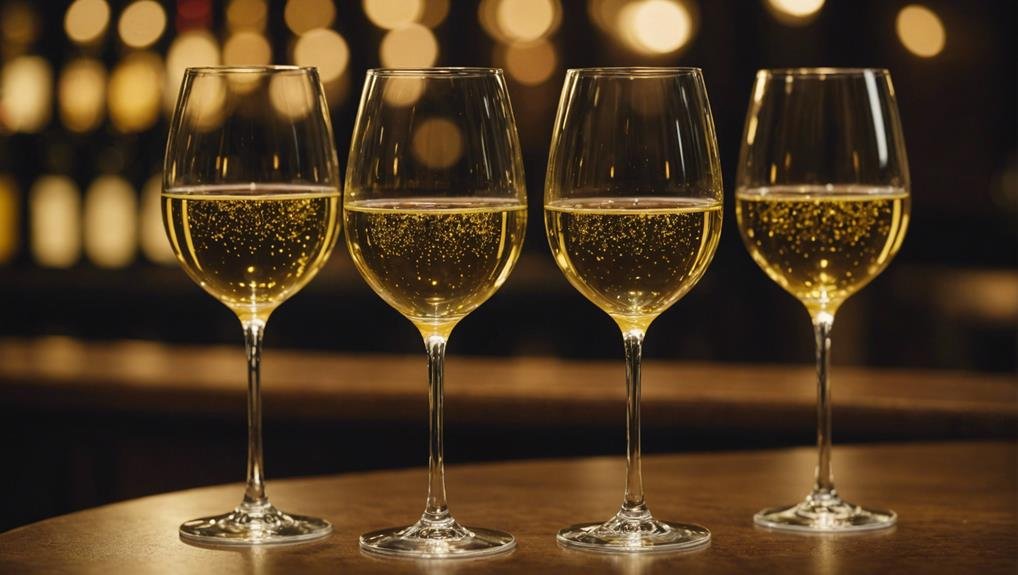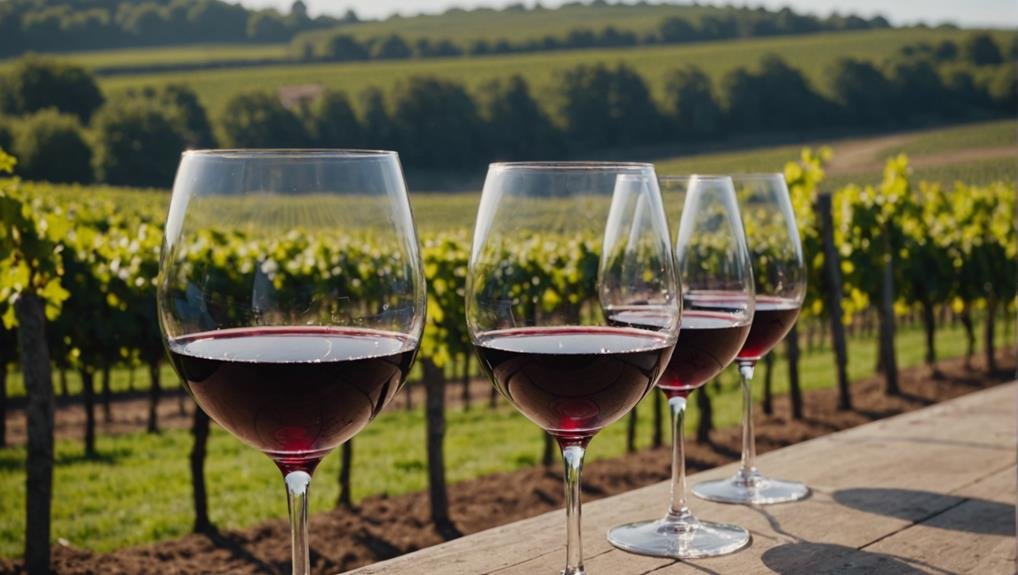The world of wines is a diverse tapestry of flavors waiting to be explored. From the elegant Chardonnays of Chablis to the robust Malbecs of Mendoza, each bottle carries a unique story of soil, climate, and tradition.
Beyond the first sip lies a journey of discovery, delving into the essence that sets each wine apart. So, let your taste buds wander through distant vineyards, for the adventure that awaits is as enlightening as it is intriguing.
Chardonnay Tasting Across Global Regions

Embarking on a journey to explore Chardonnay tasting worldwide allows you to discover a wide range of flavors and influences that highlight the unique characteristics of this popular white wine.
From the crisp and mineral-driven Chardonnays of Chablis, France, to the buttery and tropical fruit-forward styles of California, each region leaves its mark on the grape.
Chile is known for its vibrant and citrusy Chardonnays, while New Zealand offers bright acidity and hints of green apple. Italy presents Chardonnays with a blend of floral and nutty notes, and Western Australia showcases rich, full-bodied variations.
Oregon's Chardonnays often strike a balance between fruitiness and acidity, making the global exploration of Chardonnay a fascinating experience for wine enthusiasts.
Exploring Malbec Terroir Influence
When we delve into how terroir influences Malbec wines, we uncover a world of diverse flavors and characteristics shaped by different regions.
Malbec wines from Mendoza, Argentina, often boast rich, ripe fruit notes such as plum and blackberry, accompanied by velvety tannins and a smooth finish. This distinct profile is a result of the high altitude and sunny climate in the region.
In contrast, Malbec wines from Cahors, France, exhibit a more structured nature with firm tannins, and flavors of black currant and graphite, influenced by the limestone-rich soil in the area.
Understanding these nuances allows wine enthusiasts to appreciate how factors like soil, climate, and altitude can significantly impact the taste and style of Malbec wines. By exploring the influence of terroir on Malbec, one can embark on a sensory journey to discover the true diversity within this beloved grape varietal.
Red Wine Aging Classifications Comparison

Exploring red wine aging classifications offers valuable insights into how oak influences and flavors develop across different wine types. In Rioja wines, terms like Crianza, Reserva, and Gran Reserva denote specific aging requirements. For instance, Rioja Crianza wines typically age for a minimum of one year in oak barrels, while Gran Reserva wines may spend up to two years in oak.
On the other hand, Chianti wines have their own aging rules, where the Riserva label indicates longer oak aging compared to the normale classification. Understanding these distinctions helps in appreciating the diverse flavors and characteristics that stem from varied red wine aging methods.
Delving Into Red Wine Tannin Levels
Understanding red wine tannins is essential for fully appreciating the complexity and structure of different red wine varieties. Tannins, which come from grape skins, seeds, and stems, play a crucial role in a wine's mouthfeel, bitterness, and ability to age over time.
Here's a breakdown of tannin levels in popular red wines:
- Pinot Noir: Low tannin levels
- Grenache: Low to medium tannin levels
- Sangiovese: Medium tannin levels
- Cabernet Sauvignon: High tannin levels
Tannins offer red wines the necessary structure, but excessive amounts can result in astringency. Exploring red wines with varying tannin levels can enhance your understanding and enjoyment of the diverse array of red wine options available.
Merlot Vs Cabernet Sauvignon Evaluation

When comparing Merlot and Cabernet Sauvignon, wine enthusiasts appreciate the unique qualities each varietal brings to the table. Merlot is known for its smooth texture and easy-drinking nature, offering flavors of ripe fruit, plums, and hints of chocolate. It has softer tannins compared to Cabernet Sauvignon.
On the other hand, Cabernet Sauvignon stands out for its boldness, firm tannic structure, and aging potential. It presents flavors of blackcurrant, cedar, and herbal notes, with a fuller body than Merlot. The choice between the two depends on the occasion and food pairing.
Merlot is versatile for everyday enjoyment, while Cabernet Sauvignon pairs well with hearty dishes and has great aging capabilities. Both varietals showcase the diverse and complex world of wine, catering to different preferences and palates.
Pinot Noir Taste Profile Variations
Exploring the diverse flavors of Pinot Noir reveals how climate shapes this delicate wine. Pinot Noir, known for its light to medium body, offers a range of tastes based on where it's grown.
In cooler regions like Burgundy, France, it often shows red fruit notes like cherry and raspberry, with earthy hints. Conversely, Pinot Noir from warmer areas like California may feature riper fruit flavors such as plum and black cherry, sometimes with spicy undertones.
Understanding these flavor differences enriches your enjoyment of Pinot Noir and highlights how climate influences wine characteristics.
Bordeaux Blends From Diverse Regions

Bordeaux blends from various regions bring together Cabernet Sauvignon and Merlot in a harmonious blend, showcasing a delightful mix of terroirs and winemaking styles. These blends, hailing from Bordeaux, Western Australia, Napa Valley, Stellenbosch, and Columbia Valley, offer a diverse range of flavors and scents.
Typically, Bordeaux blends marry the structure of Cabernet Sauvignon with the softness of Merlot, resulting in well-balanced wines with intricate layers. Each region infuses its own distinct characteristics, influenced by factors like climate, soil, and winemaking methods.
From the traditional Bordeaux blends of France to the bold interpretations from Tuscany, Chile, and Argentina, exploring these diverse variations promises an enriching journey for wine lovers seeking depth and diversity in their tasting experiences.
Frequently Asked Questions
How Does the Aging Process Affect the Texture of Red Wine?
As red wine ages, its texture undergoes changes such as tannins softening, flavors integrating, and complexity enhancing. Oak aging contributes smoothness and richness, while bottle aging allows flavors to develop over time. The texture transitions from initially firm and astringent in young wines to a velvety and intricate feel in more mature vintages.
What Are the Health Benefits Associated With Red Wine Tannins?
Red wine tannins provide potential health benefits such as antioxidants, support for heart health, and possibly anti-inflammatory effects. These tannins can be found in a variety of red wines, adding complexity and structure to the wine, which enhances the overall tasting experience.
Can Terroir Influence Be Tasted in Different Malbec Wines?
The distinct influence of terroir can be noticed in various Malbec wines, showcasing nuanced flavors and aromas. When comparing Malbec wines from Mendoza, Argentina, and Cahors, France, the regional characteristics play a significant role in shaping the unique profiles of these wines. This highlights how terroir impacts the overall taste and experience of the wine, making each bottle a reflection of its specific geographical origins.
What Are the Key Differences Between Oaked and Unoaked Chardonnay?
Chardonnay can be aged in oak barrels, which adds flavors like vanilla, butter, and toast, influencing its color, aroma, and taste, creating a creamy texture. On the other hand, unoaked Chardonnay showcases pure fruit flavors, crisp acidity, and a lighter body without the oak influence.
Is There a Significant Price Difference Between Merlot and Cabernet Sauvignon Wines?
When comparing Merlot to Cabernet Sauvignon, Merlot typically offers a softer, fruit-forward profile at a more affordable price point. The difference in prices can be influenced by factors such as the region, quality, and the reputation of the producer.
Conclusion
Wine enthusiasts have a world of exploration at their fingertips with the vast array of grape varietals available. Did you know that there are over 10,000 grape varieties used in winemaking across the globe?
Each bottle tells a unique story of where the grapes were grown and the skill of the winemaker, waiting to be uncovered and enjoyed. From Chardonnay to Malbec, the world of wines offers a diverse tapestry of flavors for your taste buds to savor.
Here's to embarking on exciting wine tasting adventures! Cheers!